Unit 8 Have you read Treasure Island yet? Section A 现在完成时的用法 课件(共22张PPT)
文档属性
| 名称 | Unit 8 Have you read Treasure Island yet? Section A 现在完成时的用法 课件(共22张PPT) | 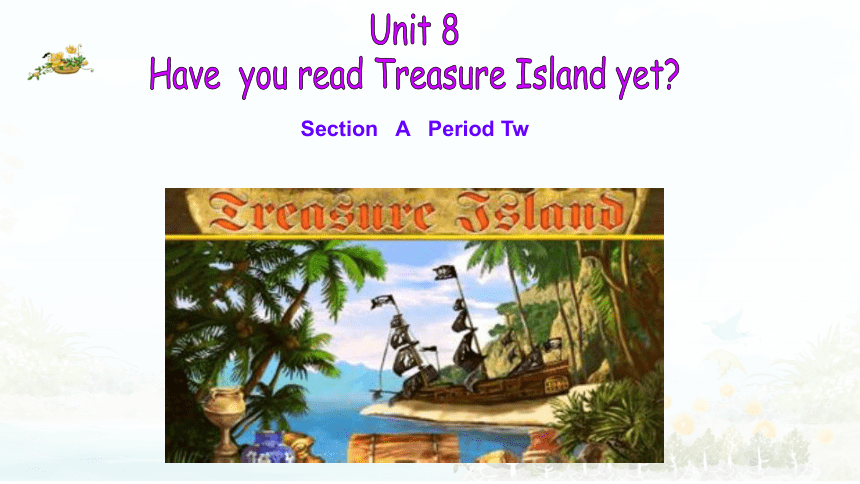 | |
| 格式 | pptx | ||
| 文件大小 | 2.2MB | ||
| 资源类型 | 教案 | ||
| 版本资源 | 人教新目标(Go for it)版 | ||
| 科目 | 英语 | ||
| 更新时间 | 2022-03-20 07:41:41 | ||
图片预览

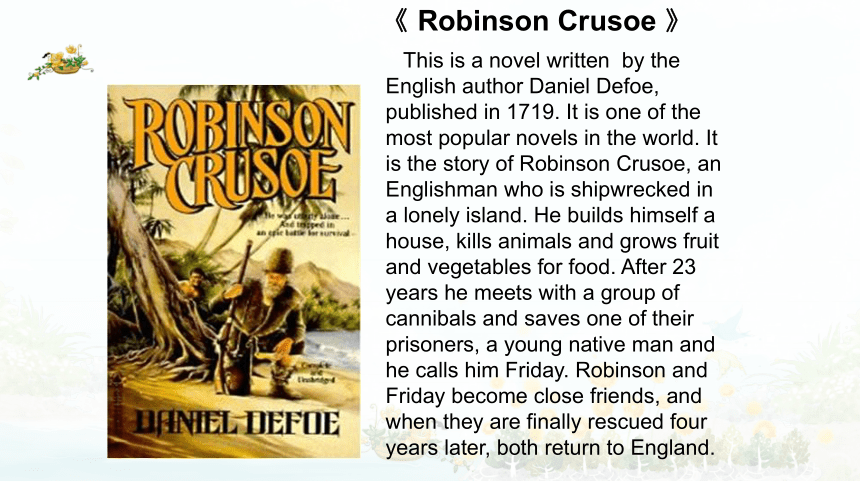
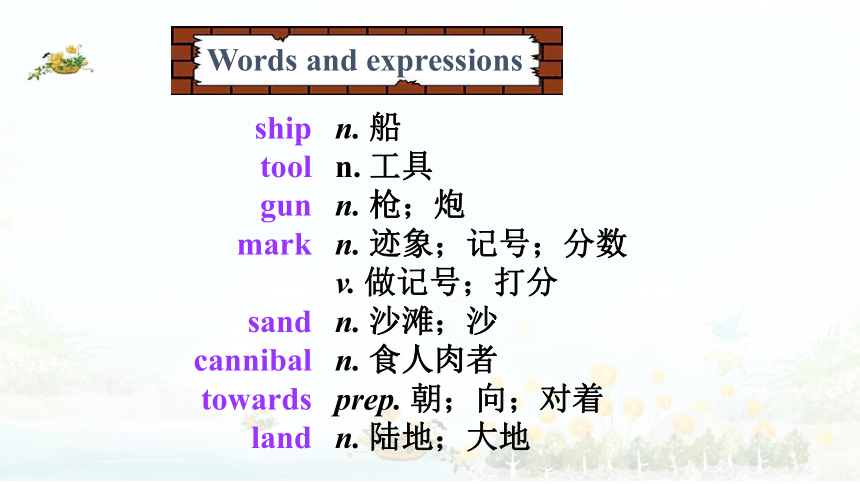
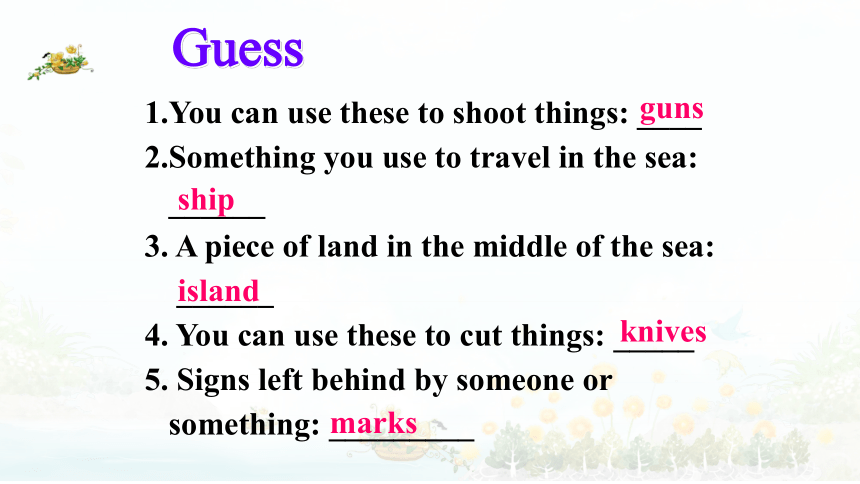
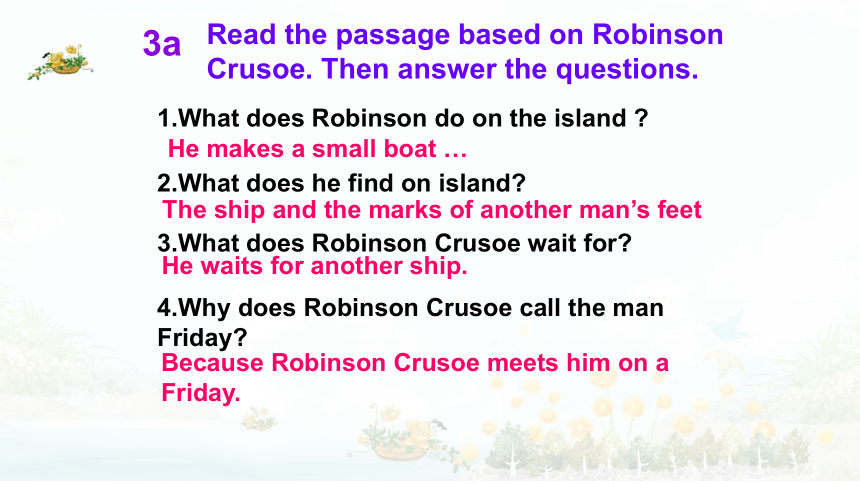
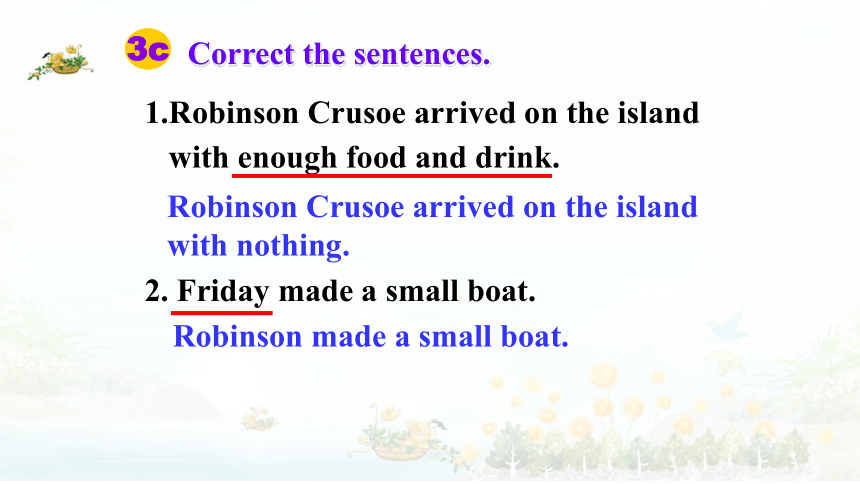
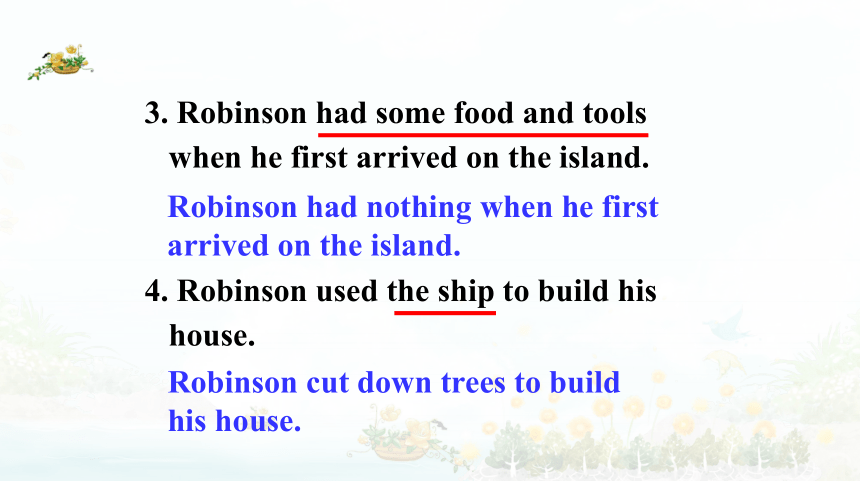
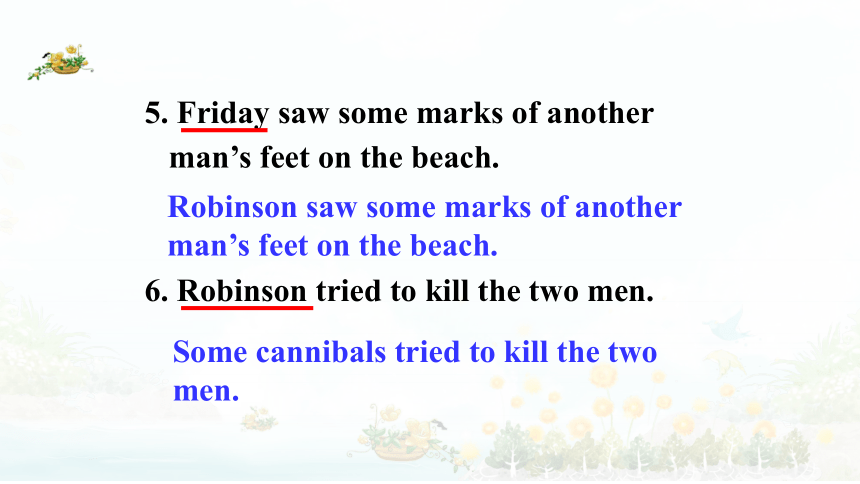
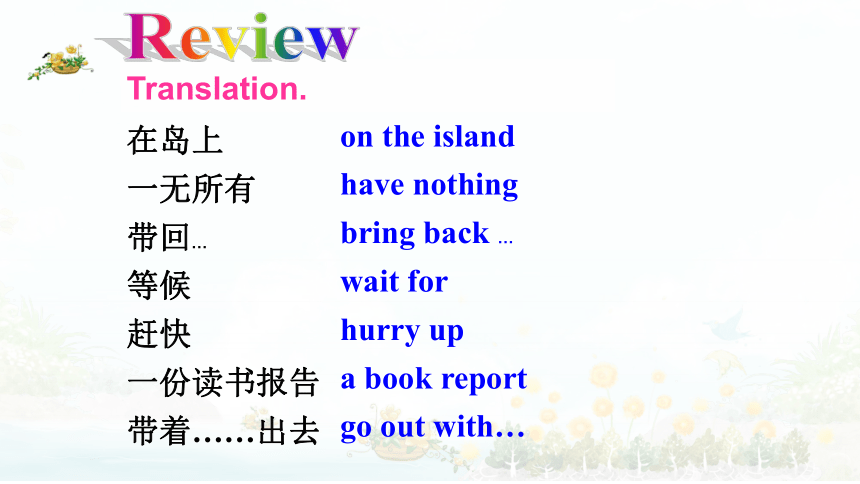
文档简介
(共22张PPT)
Unit 8
Have you read Treasure Island yet
Section A Period Tw
This is a novel written by the English author Daniel Defoe, published in 1719. It is one of the most popular novels in the world. It is the story of Robinson Crusoe, an Englishman who is shipwrecked in a lonely island. He builds himself a house, kills animals and grows fruit and vegetables for food. After 23 years he meets with a group of cannibals and saves one of their prisoners, a young native man and he calls him Friday. Robinson and Friday become close friends, and when they are finally rescued four years later, both return to England.
《 Robinson Crusoe 》
ship
tool
gun
mark
sand
cannibal
towards
land
n. 船
n. 工具
n. 枪;炮
n. 迹象;记号;分数
v. 做记号;打分
n. 沙滩;沙
n. 食人肉者
prep. 朝;向;对着
n. 陆地;大地
Words and expressions
Guess
You can use these to shoot things: ____
Something you use to travel in the sea:
______
3. A piece of land in the middle of the sea:
______
4. You can use these to cut things: _____
5. Signs left behind by someone or something: _________
guns
ship
island
knives
marks
3a
Read the passage based on Robinson Crusoe. Then answer the questions.
1.What does Robinson do on the island
2.What does he find on island
3.What does Robinson Crusoe wait for
4.Why does Robinson Crusoe call the man Friday
He makes a small boat …
The ship and the marks of another man’s feet
He waits for another ship.
Because Robinson Crusoe meets him on a Friday.
Correct the sentences.
3c
Robinson Crusoe arrived on the island with enough food and drink.
2. Friday made a small boat.
Robinson Crusoe arrived on the island with nothing.
Robinson made a small boat.
3. Robinson had some food and tools when he first arrived on the island.
4. Robinson used the ship to build his house.
Robinson had nothing when he first arrived on the island.
Robinson cut down trees to build his house.
5. Friday saw some marks of another man’s feet on the beach.
6. Robinson tried to kill the two men.
Robinson saw some marks of another man’s feet on the beach.
Some cannibals tried to kill the two men.
在岛上
一无所有
带回…
等候
赶快
一份读书报告
带着……出去
on the island
have nothing
bring back …
wait for
hurry up
a book report
go out with…
Translation.
Review
不久之后
教某人某事
学着做某事
放弃
砍倒树木
建造房屋
not long after that
teach sb. sth.
learn to do sth.
give up
cut down trees
build a house
Homework
Review the new words and
expressions.
2. 发挥想象,连词成文(50-100字)。
ship, tool, gun, mark, sand, towards, land
现在完成时态在不同语境中的基本用法
现在完成时的用法
导 入
S1
I studied English six years ago.
S2
I have studied English for six years.
现在完成时的构成
1.肯定句:主语+助动词have/has+动词过去分词
The Greens have worked in China since 1998.
2.否定句:主语+助动词has/have+not+动词过去分词
We haven’t seen each other for a long time.
3.疑问句:助动词has/have+主语+动词的过去分词
Have you ever seen the film
动词变为过去分词形式
1.一般在动词原形后加ed。
2.以e结尾的动词直接加d。
3.以辅音字母加y结尾的动词,变y为i,再加ed。
4.末尾只有一个辅音字母的重度闭音节词,双写该辅音字母,再加ed。
5.不规则变化单独记。
现在完成时的用法
1.表示过去表发生的某一动作或者状态对现在造成的影响或结果。
2.表示开始于过去并持续到现在的动作或状态,表示持续动作或状态的词多为延续性动词。
I have borrowed library books for three months.
I have kept library books for three months.
短暂性动词
延续性动词
√
现在完成时的用法
3. 现在完成时可以和不明确指出时间的状语使用。
现在完成时态的标志性词或短语有:
1.already、just、ever、never、yet、before;
2.时间状语:recently、so far、 in the past +一段时间
3.For+时间段、since+时间点;
4.次数,例如once、twice 。
现在完成时态与一般过去时态的区别
一般过去时态表示过去某个具体时间发生的动作或者状态,需要和某个过去的时间点连用,如yesterday、last year,a mouth ago。
I have read the book.
现在完成时不能与过去某个具体时间或某段时间连用,因为它只强调了过去的动作对现在造成的结果或者影响。
I read the book last Sunday.
练一练
Zhao Lan_______already_____ in this school for two years .
A. was ; studying B. will ; study
C. has ; studied D. are ; studying
√
I ________ mountain climbing yesterday.
A.went B.have gone C.gone
√
He_____ the car for a week.
A. bought B. has bought C. has had
√
练一练
你做完作业了吗
_______you ________your homework yet
Have
finished
我没有打扫我的房间。
I _________ ___________my room.
haven’t cleaned
总 结
(一)现在完成时的构成
1.肯定句:主语+助动词have/has+动词过去分词。
2.否定句:主语+助动词has/have+not+动词过去分词
3.疑问句:助动词has/have+主语+动词的过去分词
(二)现在完成时的用法
1.表示过去表发生的某一动作或者状态对现在造成的影响或结果。
2.表示开始于过去并持续到现在的动作或状态。
(三)现在完成时态与一般过去时态的区别
一般过去时态表示过去某个具体时间发生的动作或者状态,需要和某个过去的时间点连用。现在完成时不能与过去某个具体时间或某段时间连用,因为它只强调了过去的动作对现在造成的结果或者影响。
Thanks for listening!
Unit 8
Have you read Treasure Island yet
Section A Period Tw
This is a novel written by the English author Daniel Defoe, published in 1719. It is one of the most popular novels in the world. It is the story of Robinson Crusoe, an Englishman who is shipwrecked in a lonely island. He builds himself a house, kills animals and grows fruit and vegetables for food. After 23 years he meets with a group of cannibals and saves one of their prisoners, a young native man and he calls him Friday. Robinson and Friday become close friends, and when they are finally rescued four years later, both return to England.
《 Robinson Crusoe 》
ship
tool
gun
mark
sand
cannibal
towards
land
n. 船
n. 工具
n. 枪;炮
n. 迹象;记号;分数
v. 做记号;打分
n. 沙滩;沙
n. 食人肉者
prep. 朝;向;对着
n. 陆地;大地
Words and expressions
Guess
You can use these to shoot things: ____
Something you use to travel in the sea:
______
3. A piece of land in the middle of the sea:
______
4. You can use these to cut things: _____
5. Signs left behind by someone or something: _________
guns
ship
island
knives
marks
3a
Read the passage based on Robinson Crusoe. Then answer the questions.
1.What does Robinson do on the island
2.What does he find on island
3.What does Robinson Crusoe wait for
4.Why does Robinson Crusoe call the man Friday
He makes a small boat …
The ship and the marks of another man’s feet
He waits for another ship.
Because Robinson Crusoe meets him on a Friday.
Correct the sentences.
3c
Robinson Crusoe arrived on the island with enough food and drink.
2. Friday made a small boat.
Robinson Crusoe arrived on the island with nothing.
Robinson made a small boat.
3. Robinson had some food and tools when he first arrived on the island.
4. Robinson used the ship to build his house.
Robinson had nothing when he first arrived on the island.
Robinson cut down trees to build his house.
5. Friday saw some marks of another man’s feet on the beach.
6. Robinson tried to kill the two men.
Robinson saw some marks of another man’s feet on the beach.
Some cannibals tried to kill the two men.
在岛上
一无所有
带回…
等候
赶快
一份读书报告
带着……出去
on the island
have nothing
bring back …
wait for
hurry up
a book report
go out with…
Translation.
Review
不久之后
教某人某事
学着做某事
放弃
砍倒树木
建造房屋
not long after that
teach sb. sth.
learn to do sth.
give up
cut down trees
build a house
Homework
Review the new words and
expressions.
2. 发挥想象,连词成文(50-100字)。
ship, tool, gun, mark, sand, towards, land
现在完成时态在不同语境中的基本用法
现在完成时的用法
导 入
S1
I studied English six years ago.
S2
I have studied English for six years.
现在完成时的构成
1.肯定句:主语+助动词have/has+动词过去分词
The Greens have worked in China since 1998.
2.否定句:主语+助动词has/have+not+动词过去分词
We haven’t seen each other for a long time.
3.疑问句:助动词has/have+主语+动词的过去分词
Have you ever seen the film
动词变为过去分词形式
1.一般在动词原形后加ed。
2.以e结尾的动词直接加d。
3.以辅音字母加y结尾的动词,变y为i,再加ed。
4.末尾只有一个辅音字母的重度闭音节词,双写该辅音字母,再加ed。
5.不规则变化单独记。
现在完成时的用法
1.表示过去表发生的某一动作或者状态对现在造成的影响或结果。
2.表示开始于过去并持续到现在的动作或状态,表示持续动作或状态的词多为延续性动词。
I have borrowed library books for three months.
I have kept library books for three months.
短暂性动词
延续性动词
√
现在完成时的用法
3. 现在完成时可以和不明确指出时间的状语使用。
现在完成时态的标志性词或短语有:
1.already、just、ever、never、yet、before;
2.时间状语:recently、so far、 in the past +一段时间
3.For+时间段、since+时间点;
4.次数,例如once、twice 。
现在完成时态与一般过去时态的区别
一般过去时态表示过去某个具体时间发生的动作或者状态,需要和某个过去的时间点连用,如yesterday、last year,a mouth ago。
I have read the book.
现在完成时不能与过去某个具体时间或某段时间连用,因为它只强调了过去的动作对现在造成的结果或者影响。
I read the book last Sunday.
练一练
Zhao Lan_______already_____ in this school for two years .
A. was ; studying B. will ; study
C. has ; studied D. are ; studying
√
I ________ mountain climbing yesterday.
A.went B.have gone C.gone
√
He_____ the car for a week.
A. bought B. has bought C. has had
√
练一练
你做完作业了吗
_______you ________your homework yet
Have
finished
我没有打扫我的房间。
I _________ ___________my room.
haven’t cleaned
总 结
(一)现在完成时的构成
1.肯定句:主语+助动词have/has+动词过去分词。
2.否定句:主语+助动词has/have+not+动词过去分词
3.疑问句:助动词has/have+主语+动词的过去分词
(二)现在完成时的用法
1.表示过去表发生的某一动作或者状态对现在造成的影响或结果。
2.表示开始于过去并持续到现在的动作或状态。
(三)现在完成时态与一般过去时态的区别
一般过去时态表示过去某个具体时间发生的动作或者状态,需要和某个过去的时间点连用。现在完成时不能与过去某个具体时间或某段时间连用,因为它只强调了过去的动作对现在造成的结果或者影响。
Thanks for listening!
同课章节目录
- Unit 1 What's the matter?
- Section A
- Section B
- Unit 2 I'll help to clean up the city parks.
- Section A
- Section B
- Unit 3 Could you please clean your room?
- Section A
- Section B
- Unit 4 Why don't you talk to your parents?
- Section A
- Section B
- Unit 5 What were you doing when the rainstorm came
- Section A
- Section B
- Review of Units 1-5
- Unit 6 An old man tried to move the mountains.
- Section A
- Section B
- Unit 7 What's the highest mountain in the world?
- Section A
- Section B
- Unit 8 Have you read Treasure Island yet?
- Section A
- Section B
- Unit 9 Have you ever been to a museum?
- Section A
- Section B
- Unit 10 I've had this bike for three years.
- Section A
- Section B
